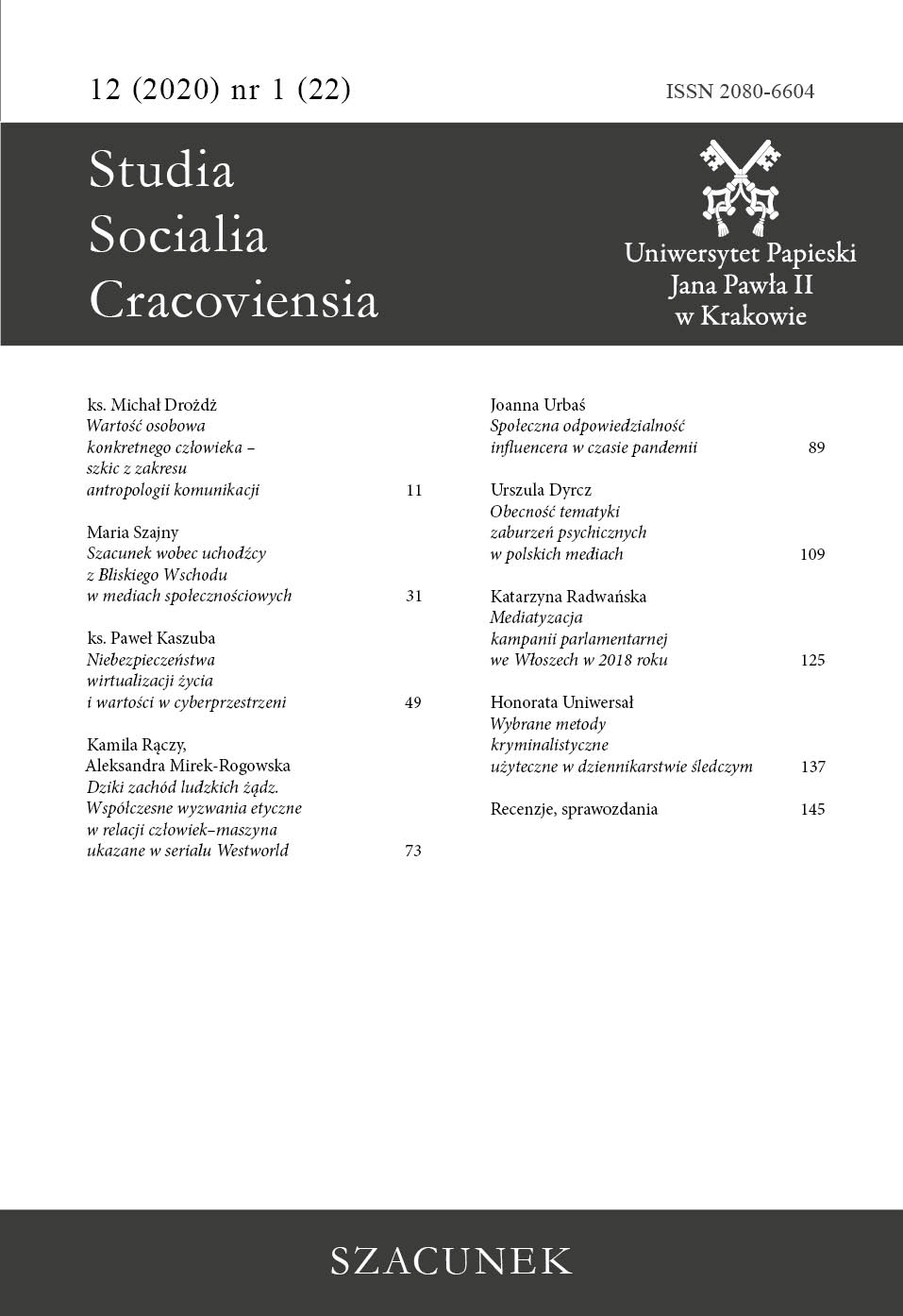Contemporary ethical challenges in the man-machine relationship, shown in the Westworld series
DOI:
https://doi.org/10.15633/ssc.4149Keywords:
ethics, posthumanism, new technologies, media, WestworldAbstract
Contemporary ethical challenges in the man-machine relationship, shown in the Westworld series. The possibilities of new technologies represent a considerable ethical challenge for the modern world. Particular emphasis is placed on the relationship between both human and machine. The Westworld series is an example of a current media tool showing a futuristic vision of the existence of a world consisting not only of people, but also robots, resembling to an illusion of man. The production presents a spectrum of ethical threats and moral dilemmas shown in human ethos. A serial syntax for ethical reflection and moral judgment of the dystopian vision of the future and human actions. This article is an attempt to show the post-humanistic, technological reality, in the perspective and era of the realization of transhumanistic transformations and new perspectives, while evaluating the moral issues that accompany human existence. Moreover, the urgent need to reflect on the essence of the development of new technologies, on the human being who exists in them, and on the consequences of their ethical and existential nature, leads the mediators to find solutions to the above-mentioned problems, this is the attitude to human prototypes.
References
Bogunia-Borowska M., Fenomen telewizji. Interpretacje socjologiczne i kulturowe, Kraków 2012.
Bostrom N., The Transhumanist FAQ Version 2.1, Oxford U.K. 2003.
Callus I., Herbrechter S., Introduction: Posthumanist subjective, or coming after the subject…, „Subjectivity” (2012) no. 5, s. 241–264.
Domańska E., Zwrot performatywny we współczesnej humanistyce, „Teksty Drugie” 2007 nr 5, s. 48–61.
Goh I.,The Reject: Community, Politics, and Religion after the Subject, New York 2014.
Gorman L., McLean D., Media i społeczeństwo. Wprowadzenie historyczne, Kraków 2010.
Grossberg L., Affect’s Future: Rediscovering the Virtual in the Actual (Interviewed by Gregory J. Seigworth & Melissa Gregg), w: The Affect Theory Reader, ed. G.J. Seigworth, M. Gregg, Durham & London 2010, s. 309–338.
Haraway D.J., When Species Meet, London 2008.
Hayles N.K., How We Became Posthuman. Virtual Bodies in Cybernetics, Literature, and Informatics, Chicago, London 1999.
Hofstadter D.R., Gödel, Escher, Bach: An Eternal Golden Braid, New York 1984.
Kulawiński M., Transhumanizm, cyborgizacja, ulepszanie człowieka, https://www.researchgate.net/publication/334448348_Transhumanizm_cyborgizacja_ulepszanie_czlowieka#pf14 (12.08.2020).
Łapińska J., O miłości cyborgów w filmach „Uncanny” i „Sight” oraz serialach „Black Mirror” i „Westworld” w świetle wybranych teorii posthumanistycznych, w: Narracje fantastyczne, t. 5, red. K. Olkusz, K.M. Maj, Kraków 2017, s. 115–136.
Migoń M.P., Wstęp do etyki. Skrypt, Gdańsk 2013, http://paluchja-zajecia.home.amu.edu.pl/etyka/Migon_skrypt.pdf (10.08.2020).
Pepperell R., Manifest posthumanistyczny, przekł. P. Majewski, „Przegląd Filozoficzno-Literacki” 22 (2009) nr 1, s. 29–40.
Seigworth G.J., Gregg M., An Inventory of Shimmers, w: The Affect Theory Reader, ed. G.J. Seigworth, M. Gregg, Durham & London 2010, s. 1–25.
Turing A., Maszyna licząca a inteligencja, w: Fragmenty filozofii analitycznej, t. 2, red. B. Chwedeńczuk, Warszawa 1995.
Zawojski P., Posthumanizm, czyli humanizm naszych czasów, „Kultura i Historia” 2017 nr 32, s. 68–76.
Downloads
Published
Issue
Section
License
Authors who publish with this journal agree to the following terms:
- Authors retain the copyright and full publishing rights without restrictions, and grant the journal right of first publication with the work simultaneously licensed under a Creative Commons Attribution 4.0 International License that allows others to share the work with an acknowledgement of the work's authorship and initial publication in this journal.
- Authors are able to enter into separate, additional contractual arrangements for the non-exclusive distribution of the journal's published version of the work (e.g., post it to an institutional repository or publish it in a book), with an acknowledgement of its initial publication in this journal.
- Authors are permitted and encouraged to post their work online (e.g., in institutional repositories or on their website) prior to and during the submission process, as it can lead to productive exchanges, as well as earlier and greater citation of published work (See The Effect of Open Access).

